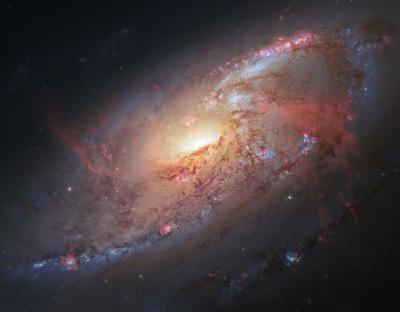Messier 106 looks like lots of other galaxies yet it hides a number of secrets. But now, it has slightly fewer than before, thanks to citizen science astronomers.
The first mystery people always wonder about is the name. Messier 106 was neither discovered nor cataloged by the 18th century astronomer Charles Messier. It was instead discovered by his assistant, Pierre Méchain, but the galaxy was never added to the catalog in his lifetime either. Instead, along with six other objects discovered but not logged by either of them, Messier 106 was posthumously added to the Messier catalog in the 20th century. Pierre does have Asteroid 21785 Méchain named in his honor, otherwise he was cheated a bit.
At its heart, as in most spiral galaxies, is a supermassive black hole, but this one is particularly active. Unlike the black hole at the center of the Milky Way, which pulls in wisps of gas only occasionally, Messier 106's black hole is actively gobbling up material. As the gas spirals towards the black hole, it heats up and emits powerful radiation. Part of the emission from the center of Messier 106 is produced by a process that is somewhat similar to that in a laser - although here the process produces bright microwave radiation.
As well as this microwave emission from Messier 106's heart, the galaxy has another startling feature - instead of two spiral arms, it appears to have four. Although the second pair of arms can be seen in visible light images as ghostly wisps of gas, as in this image, they are even more prominent in observations made outside of the visible spectrum, such as those using X-ray or radio waves.
Unlike the normal arms, these two extra arms are made up of hot gas rather than stars, and their origin remained unexplained until recently. Astronomers think that these, like the microwave emission from the galactic center, are caused by the black hole at Messier 106's heart, and so are a totally different phenomenon from the galaxy's normal, star-filled arms.
The extra arms appear to be an indirect result of jets of material produced by the violent churning of matter around the black hole. As these jets travel through the galactic matter they disrupt and heat up the surrounding gas, which in turn excites the denser gas in the galactic plane and causes it to glow brightly.
This denser gas closer to the center of the galaxy is tightly-bound, and so the arms appear to be straight. However, the looser disc gas further out is blown above or below the disc in the opposite direction from the jet, so that the gas curves out of the disc — producing the arching red arms seen here.

This image combines Hubble observations of M 106 with additional information captured by amateur astronomers Robert Gendler and Jay GaBany. Gendler combined Hubble data with his own observations to produce this stunning color image. M 106 is a relatively nearby spiral galaxy, a little over 20 million light-years away. Credit: NASA, ESA, the Hubble Heritage Team (STScI/AURA), and R. Gendler (for the Hubble Heritage Team). Acknowledgment: J. GaBany, A van der Hoeven
Amateur astronomer Robert Gendler retrieved archival Hubble images of M 106 to assemble a mosaic of the center of the galaxy. He then used his own and fellow astrophotographer Jay GaBany's observations of M 106 to combine with the Hubble data in areas where there was less coverage, and finally, to fill in the holes and gaps where no Hubble data existed.
The center of the galaxy is composed almost entirely of Hubble data taken by the Advanced Camera for Surveys, Wide Field Camera 3, and Wide Field and Planetary Camera 2 detectors. The outer spiral arms are predominantly HST data colourised with ground-based data taken by Gendler's and GaBany's 12.5-inch and 20-inch telescopes, located at very dark remote sites in New Mexico, USA.




Comments